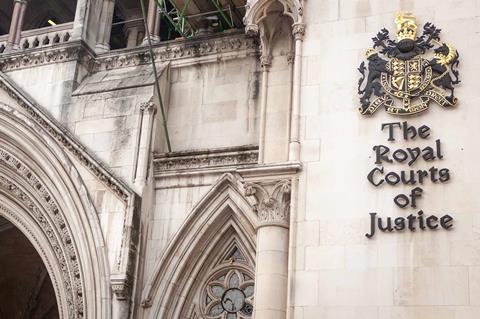In the face of worldwide turmoil this year, the courts remained undeterred and decided a number of important property law cases. Mathew Ditchburn, partner and head of the real estate disputes team at Hogan Lovells, and Lien Tran, an associate in the real estate disputes team at Hogan Lovells, summarise their highlights from 2020.

Restrictive covenants: Alexander Devine Children’s Cancer Trust v Housing Solutions Ltd
A developer owned land subject to a restrictive covenant, in favour of an adjoining children’s hospice, that it could only be used as a car park. The covenant ensured that the hospice remained private and was not overlooked. In full knowledge of the breach, the developer built 13 affordable homes. It then applied to modify the covenant under section 84 of the Law of Property Act 1925 to permit the development.
Although the affordable housing was in the public’s interest, the Supreme Court held that it did not outweigh the public interest in maintaining the hospice’s contractual rights. The court refused the application to modify the covenant, as the developer should not be entitled to rely on its own unlawful conduct as a justification for modification.
Landlord’s consent: Duval v 11-13 Randolph Crescent Ltd
A tenant in a block of flats requested the landlord’s consent for alterations. Under the terms of all the leases in the block, such alterations were prohibited and the landlord had covenanted to enforce the covenants in the other tenants’ leases. When the landlord granted consent for the tenant’s works, a neighbouring resident claimed that this was a breach of the landlord’s covenant.
The Supreme Court decided that there was an implied covenant by the landlord not to do anything that would prevent it from enforcing the tenants’ covenants in the other leases. The covenant would otherwise be useless if the landlord could modify, vary or permit breaches as it pleased.
Rights of light: Beaumont Business Centres Ltd v Florala Properties Ltd
Florala carried out works to its property to increase the height of the building. Beaumont, a neighbouring tenant that used its property for serviced offices, suffered a reduction in light and applied to court for an injunction. Beaumont’s building was already poorly lit and used artificial lighting, so Florala argued that it was not an actionable nuisance.
The High Court held that the loss of light resulted in a loss of rental income that was more than de minimis. The court granted an injunction as this amounted to a substantial interference with the reasonable enjoyment of Beaumont’s property.
CRAR and forfeiture: Brar & another v Thirunavukkrasu
Thirunavukkrasu failed to pay rent on his property and the landlord exercised commercial rent arrears recovery (CRAR) by taking control of the tenant’s goods. The landlord exercised CRAR on 1 February 2016 and subsequently forfeited the lease for non-payment of rent on 12 February 2016.
The tenant claimed that the forfeiture was unlawful because exercising CRAR had waived the right to forfeit. The Court of Appeal agreed and held that the landlord’s exercise of CRAR was an unequivocal representation that the lease was continuing, which had waived the right to forfeit.
AGAs and GAGAs: EMI Group Limited v The Prudential Assurance Company Ltd
EMI provided a guarantee of HMV‘s lease obligations of its Oxford Street store. In 2011, HMV assigned its lease and provided an authorised guarantee agreement (AGA) to guarantee the assignee’s obligations. EMI’s original guarantee extended to a guarantee of the AGA (GAGA). When the assignee stopped paying rent and HMV was already dissolved, the landlord called on EMI‘s GAGA.
Under the lease, the tenant could only be required to give an AGA if it was reasonable to do so, but EMI would automatically be required to guarantee any AGA. EMI argued that the GAGA fell foul of the anti-avoidance provisions in the 1995 Act, because a guarantor must be released “to the same extent” as a tenant on assignment. However, the court disagreed and held that the focus of that provision is on the fact that the guarantor will be released when the tenant is released and not on the terms upon which the AGA/GAGA can be required.

Quiet enjoyment and nuisance: Jafari v Tareem Ltd
Jafari had a lease of a dental practice. The landlord redeveloped the remainder of the building, which involved noisy works and scaffolding outside the dental practice. However, as compensation for the disturbance, the landlord waived the rent for the period of the works. Jafari claimed that the works irreparably damaged his business’s profitability and withheld further rent.
The court held that the landlord had taken all reasonable steps to minimise disturbance to Jafari and offered compensation by way of the rent waiver, which made reasonable what might have otherwise been unreasonable.
Telecoms: Cornerstone Telecommunications Infrastructure Ltd v University of the Arts London
The Electronic Communications Code allows telecoms operators to acquire rights over private land to install their apparatus, if they can establish that the prejudice caused to the landowner can be adequately compensated in money and that the public benefit of imposing the rights outweighs that prejudice.
Cornerstone asked the tribunal to impose code rights for them to install and operate their apparatus on the roof of University of the Arts London (UAL). UAL had already agreed with a developer on the construction of a new building. Once the new building was complete, the university would sell its existing building to the developer but would remain in occupation under a three-year leaseback.
The tribunal found in favour of UAL and did not impose code rights. There was a real risk of litigation, both under the code to remove Cornerstone and from the developer if UAL could not deliver vacant possession after the three-year leaseback, which would create uncertainty, reputational damage and potential harm to the university’s relationship with the developer and its students.
Landlord’s rights of entry: Rees v Windsor-Clive
The landlord owned a farm in Wales, which was let to a tenant on two tenancy agreements. One allowed the landlord to enter the farm “at all reasonable times for all reasonable purposes” and the other “for the purpose of inspecting the same … or for any other purpose connected with his estate”. The landlord planned to redevelop and sought access to undertake surveys on the farm, which the tenant objected to.
The Court of Appeal held that a right to inspect should not cause any material disturbance or damage, but whether something is “material” is a matter of fact and degree and should be interpreted in context. The court also held that if the landlord’s right to enter is for a particular purpose and the purpose is reasonable, it must enable the landlord to do what is reasonably necessary to achieve that purpose. However, if the action required or the time at which it is carried out is highly intrusive, then the purpose itself may not be a reasonable one.
Injunctions: London Borough of Bromley v Persons Unknown and others
Bromley Council had obtained an interim injunction preventing “persons unknown” from encampment, entry and occupation in all public spaces in the borough. This was mainly aimed at the gypsy and traveller community, which is a protected minority under the Equality Act 2010.
When the council applied for a final injunction lasting for five years, the Court of Appeal refused on the basis that such an injunction would be too broad and too long. The council had not provided any other suitable accommodation for the traveller community and injunctions were already in place in other local authorities. A more proportionate solution may have been to apply for a shorter injunction for particularly vulnerable sites.
More restrictive covenants: 89 Holland Park Management Ltd v Hicks
Hicks wanted to develop a property that was subject to a restrictive covenant, which required her to obtain the consent of the freehold owner of a neighbouring property. The neighbouring property was split into five flats and the leaseholders had the benefit of the covenant. They rejected the plans based on aesthetic reasons and disruption. Hicks argued that the freeholder was only entitled to take account of the impact that the works might have on the freehold interest in deciding whether or not to consent.
The Court of Appeal held that the freehold owner was entitled to take into account the leaseholders’ interests and consent could be refused on aesthetic grounds.




























No comments yet